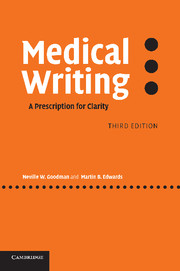Book contents
- Frontmatter
- Contents
- Preface to the first edition
- Preface to the third edition
- Acknowledgements
- PART I PROBLEM: THE ILLNESS
- PART II SOLUTION: SYMPTOMATIC RELIEF
- 3 Guidelines to clearer writing
- 4 Is there a better word?
- 5 Superfluous words
- 6 Imprecise words and phrases
- 7 Superfluous phrases
- 8 Trouble with short words
- 9 Use of the passive voice
- 10 Consistency: number and tenses
- 11 Circumlocution, metaphor and cliché
- 12 Word order and pronouns
- 13 Punctuation
- 14 Constructing sentences
- 15 Drawing clear graphs
- PART III PRACTICE: RECUPERATION
- Appendix: examples to rewrite
- References and further reading
- Index
13 - Punctuation
Published online by Cambridge University Press: 23 November 2009
- Frontmatter
- Contents
- Preface to the first edition
- Preface to the third edition
- Acknowledgements
- PART I PROBLEM: THE ILLNESS
- PART II SOLUTION: SYMPTOMATIC RELIEF
- 3 Guidelines to clearer writing
- 4 Is there a better word?
- 5 Superfluous words
- 6 Imprecise words and phrases
- 7 Superfluous phrases
- 8 Trouble with short words
- 9 Use of the passive voice
- 10 Consistency: number and tenses
- 11 Circumlocution, metaphor and cliché
- 12 Word order and pronouns
- 13 Punctuation
- 14 Constructing sentences
- 15 Drawing clear graphs
- PART III PRACTICE: RECUPERATION
- Appendix: examples to rewrite
- References and further reading
- Index
Summary
Medical writers tend to write long sentences in which one subordinate clause comes after another, sometimes with no punctuation at all. Readers may have to read a sentence two or three times to get the sense. Short sentences are more likely to be clear and less likely to cause ambiguity. This chapter deals with the basic ideas of punctuation. In Chapter 14, there is a more general discussion of the construction of sentences. (For the use of apostrophes, see p. 38.)
Punctuation has been having a much better than customary press after the runaway success of Lynne Truss's book, Eats, Shoots and Leaves (see Books to read, p. 242). Anyone who has read that book can regard this chapter as revision.
Full stops and a few commas should suffice. (Full stops are periods to North Americans, and full points to editors.) Use colons and semi-colons only if you know how. Only a full stop, not a colon, is followed by a capital letter: the text following a colon is part of the same sentence.
Some rules of punctuation are:
a semi-colon is almost a full stop;
use a colon to introduce a list;
separate the items on a list by commas not semi-colons (unless the items could themselves be sentences or have commas within them);
if you use commas to mark a parenthesis, like this, you must pair them just as you would always close a bracket;
never separate a subject from its verb by a single punctuation mark.
It is sometimes helpful when checking punctuation to read a doubtful passage aloud, exaggerating the pauses; this may show where the punctuation is incorrect or lacking, or where meaning has been altered or made ambiguous by punctuation.
- Type
- Chapter
- Information
- Medical WritingA Prescription for Clarity, pp. 173 - 178Publisher: Cambridge University PressPrint publication year: 2006



